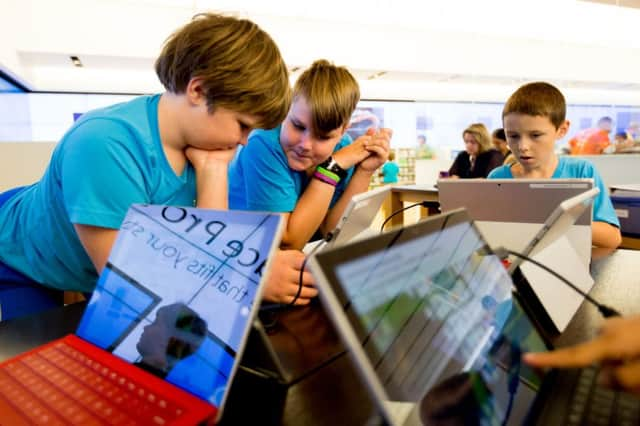How the cloud is transforming education
This article contains affiliate links. We may earn a small commission on items purchased through this article, but that does not affect our editorial judgement.


Gone are the days of shaky handwriting as your homework jotter bounced up and down with the pot holes. Instead, pupils are using their laptops, tablets and smartphones to turn their bus rides into useful time for reading material chosen by their teachers or practicing their homework assignments, which may have been set either for individuals or for pupils to collaborate in groups.
“Cloud computing is enabling school pupils to experience anytime, anywhere learning,” explains Andrew Robertson, a digital storyteller in Microsoft’s education team.
Advertisement
Hide AdAdvertisement
Hide Ad“Our children are going to find their own ways of learning – they’re going to work out what method works best for them and they’re going to use technology to help do it.”


At its simplest, the idea behind cloud computing is that programs and files are stored remotely on servers instead of on the hard drives of individual computers. This means that users can access the information from anywhere that they can use the internet or a private network to connect to those servers, freeing up people to work out on the road or at home rather than in their office and allowing colleagues from around the world to collaborate on the same task or project.
In Scotland, the Glow Programme allows teachers and learners to benefit from technology. Ian Stuart, Principal Teacher of Technology, Argyll & Bute Council says:
“Using Glow to access Cloud services has allowed the development of Collaboration across Scotland. Pupils working on similar topics are sharing ideas and discussing and sharing their learning. Teachers are sharing ideas and developing resources. This is no matter where they are.”
And in Falkirk, an ICT Development Officer comments on the flexibility and way that users now interact -


“Working on an online space provides a collaborative space for learners to work on tasks in and out of the classroom, using their own device or school or family device, so the learning is where and when they need it”
Flip learning
One of the most exciting possibilities that the cloud has opened up for education is the concept of “flip learning”. Traditionally, teachers would have stood at the front of the classroom and delivered a lesson, telling pupils facts and figures that they needed to remember for tests and exams, before setting them homework to be completed in their own time.
Advertisement
Hide AdAdvertisement
Hide AdTechnology has allowed this practice to be “flipped” on its head; pupils now use their own devices to read material set by their teachers and then come into the classroom ready to ask questions. Such flip learning allows teachers to concentrate on answering pupils’ questions about concepts with which they’ve struggled and turns the classroom into a place where pupils can do exercises with which they might have struggled at home and collaborate in groups.
Underpinning flip learning are tools such as OneNote, part of the suite of software that forms Office 365 Education. OneNote is a program that allows teachers to create shared workspaces for pupils; they can show children what information to read, set them classroom or homework assignments, and create group tasks for pupils to work on together.
Having a copy of Office 365 Education means that pupils can install the software on multiple devices – so they can have the same programs on their computer at school, their family’s laptop at home, their own tablet and their ever-present smartphone. These days, the programs are also “platform agnostic” – which means they can work on PCs, tablets running the Android operating system or even Apple devices like iMacs and iPads – a far cry from ten or 15 years ago when it was difficult to work across different devices.
OneNote has proved so useful for Sandi Adams – a technology project specialist for Cherokee County School District in Georgia, United States – that it’s been branded as “the Swiss Army Knife of education”.
“OneNote organises by sections or group sections with unlimited pages packed with documents, photos, emails, spreadsheets, recordings, inking and so much more,” says Adams.
“It gives me the ability to collaborate with colleagues and students and, best of all, I can access the most current version of my notebooks from my phone, iPad, Microsoft Surface, desktop or laptop.”
In the mix
While OneNote allows teachers to set pupils’ homework, another plugin – or extension – can also help them to monitor children’s progress. Office Mix allows teachers to record audio messages or even videos and then embed them into PowerPoint presentations that pupils can watch.
Office Mix can also be used to embed quizzes and other tests into learning materials and it also keeps a record of how long pupils spend looking at each slide, which can be used to give teachers an idea about the topics with which their class might be struggling, leading to changes to lesson plans.
Advertisement
Hide AdAdvertisement
Hide Ad“I have been using Office Mix to add audio or video introductions to PowerPoint presentations for pupils who have missed lessons,” explains Matthew Davies, from Treorchy Comprehensive School in South Wales.
“The audio or video gives pupils the detail or context that I would have spoken about in the lesson. This has allowed pupils to catch-up prior to the next lesson, in school or at home. They are then ready to move on with the rest of the class on their return.”
Exposing children to Office 365 can also give them an advantage when it comes to leaving school and finding a job. “Employers don’t want to spend time training staff how to use industry-standard programs like Office,” says Robertson. “If students already know how to use Word, Excel and PowerPoint then it could help them when applying for work.”
Skype-a-thon
Cloud computing has also opened up a whole new world when it comes to school trips.
Skype In The Classroom, the video conferencing service, allows students to receive video tours of remote locations that would be too far away or too expensive to visit.
The program also enables teachers to welcome virtual guest lecturers into the classroom so that students can hear directly from the experts and ask them questions.
“Microsoft held a Skype-a-thon on 3 and 4 December 2015, which involved thousands of guest teachers, speakers and students connecting with each other throughout the world,” says Robertson.
Advertisement
Hide AdAdvertisement
Hide Ad“Over those two days, users connected to each other across more than 3,000,000 miles – that’s the equivalent of 120 times around the world.”
Pupils aren’t just connecting via video links; Yammer, another part of the Office family, is a social network that can be used by pupils and teachers to hold discussions. Most children will be too young to use open social networks like Facebook, so Yammer gives staff a secure and controlled environment, allowing them to choose who does and who doesn’t have access.
Cloud computing isn’t restricted to the physical world either – it also provides the power behind Minecraft, the online game that allows players to build their own virtual environment using very retro-style blocks.
School pupils have used Minecraft for everything from coming up with designs for the athletes’ village at the 2014 Commonwealth Games in Glasgow through to creating virtual Viking ships for an invasion of Scotland.
With cloud computing powering applications as varied as Office Mix, Skype In The Classroom and Minecraft, the tools available to teachers are growing each and every day.
– This article was produced in partnership with Microsoft